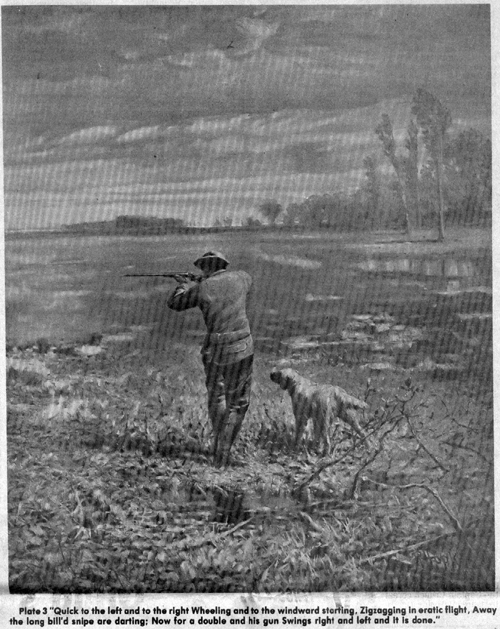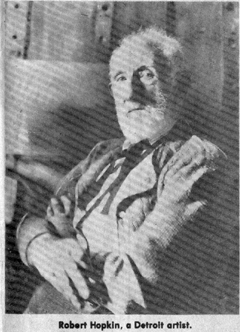November 19, 1981


Picture #1 – Plate 3 “Quick to the left and to the right Wheeling and to the windward starting Zigzagging in erratic flight, Away the long bill’d snipe are darting; Now for a double and his gun Swings right and left and it is done.
Picture #2 – Robert Hopkin, a Detroit artist
You never know what’s hidden away in your attic…if you have one…or maybe a closet or basement.
When the Tony Filliater family, 237 W. Tiffin Street, started exploring their attic they never expected to find a set of lithographed prints from the original paintings by a famous artist.
Mrs. Filliater telephoned me and asked if I knew the value of the prints, or how to find out. Having an investigative nature, I asked if I could look at them. One look at them and I was captivated. There were eight prints, part of the original set of 12, depicting a variety of outdoor scenes. The set was in a protective cover, and thus well preserved. Each print contained the signature of Robert Hopkin, the artist who had done the originals.
How did I discover further details about Hopkin and his works of art? My first port of call was Kaubisch Memorial Public Library, where Pat Bowman found that the Cyclopedia of American Biography listed Robert Hopkin.
He was born in Glasgow, Scotland, Jan 3, 1832, son of Robert and Jeanne (Miller) Hopkin. His grandfather was a sea captain of Rothsay, and often took the lad on his coasting trips, where he saw the great ships of the world, and where the mystery and fascination of the sea came upon him. His love for art was inborn. As his father was the librarian of the Glasgow Public Library, the son spent many hours pouring over art books and engravings there.
CAME TO U.S. 1842
When he was 10 years old, his parents came to America, settling in Detroit, Michigan, where with the exception of his cruises abroad and a brief residence in Chicago, IL., he lived for the rest of his life. He spent much of his youth along the wharves of Detroit, and his first marine picture, painted at the age of 15, so pleased his employer that the latter exhibited it in a store window on Woodward Avenue. The only instruction he obtained was from Frederick E. Cohen, a portrait painter, who taught him how to mix colors.
Hopkin now took up scene painting, which was followed by mural decorations for churches and public buildings, and was so successful in that line that in 1870 he moved with his family to Chicago, where he had steady commissions and good prices, but the great fire of 1871 destroyed his studio, and he returned to Detroit.
The first drop curtain in the old Detroit opera house was painted by Hopkin. It was destroyed by fire in 1897. He made frequent trips throughout the west from 1860 to 1885, painting scenery and curtains for theaters and mural paintings for public buildings. Perhaps the best of the latter was owned by the Cotton Exchange of New Orleans, comprising four marine views in panel form, for which he was paid $2,500. At the same time he was painting a large number of sea views which found a ready sale. It is said the artist himself did not know their number, and no two were alike. Many of the pictures were without dates.
VERSATILE ARTIST
While his chief fame and success was in his marines, he was equally successful in landscapes and woodlands, especially his Scotch mountains and quaint old street scenes of New Orleans, Savannah, Boston and Portsmouth.
The eight prints discovered locally, part of the original set of 12, were done to illustrate Thomas Watson’s poem. “The Sportsman’s Reverie”. At the bottom of each one of the scenes is a portion of the poem which inspired that particular work. That set of prints were published by Sportsman’s Publishing Co., Detroit, in 1897, and printed by The Heliotype Printing Co., Boston, Mass.
A search was made for the complete poem at the Kaubisch Library and also the Toledo Library, but it was not found. Consequently, at least for this article, the only reference for the poem are the verses which appear at the bottom of each of the prints found locally.
MYSTERY SOLVED
How did the set of Hopkin’s prints find their way into the Filliater attic? Who put them there? It is an interesting story which takes us back to the earlier part of this century. It unraveled as I talked with various people, including Fostorians Corine Speck and Mrs. Glen Marshall, and corresponded with Thomas Faulhaver, once a resident of the house at 237 W. Tiffin St.
The house was constructed for L.J. Eshelman, a prominent resident and businessman in Fostoria, having operated a drugstore. Date for construction is pegged at about 1908, since the 1909-10 directory was the first his residence showed at 237 W. Tiffin St.
That property was later sold to John L. Faulhaver, who was associated with Dave Balmer in the hardware business, and was also proprietor of Fostoria Steel Roofing Co. A 1919 directory showed the Faulhaver family living at 237 W. Tiffin, but they may have moved there between 1915 and 1919.
FOSTORIA’S FIRST FORD DEALER
Willis J. Hakes acquired the property from Faulhaver in 1928 and lived there until 1969, when it was sold to Mr. and Mrs. Donald E. Jacobs, the parents of Mrs. Filliater who with her husband are now owners.
The Faulhabers had six children, two boys who died during youth. Eunice, Esther and twins Thomas and Mary.
FAULHABER FAMILY
Corine Speck, 521 W. Center St. was a close friend of Esther Faulhaber, both being in school together in Fostoria, and it was she that suggested that perhaps the Hopkin prints were originally owned by Esther, and left there when the family moved to Cleveland.
A letter from Thomas Faulhaber, Vero Beach, Fla., revealed that his sister Esther was a teacher of art in the Cleveland school for many years as well as being an artist herself.
My sister had many prints and may have been the owner. She had entrys in the “May Show” and won some prizes, and took a teaching sabbatical to go abroad and teach in Albania, teaching King Zoggs daughters, said Thomas.
Therefore it is responsible to believe that Esther Faulhaber acquired the lithographed prints from the Hopkin’s originals and stored them in the family residence at 237 W. Tiffin St.; probably forgetting about them in the passing years, and at the time the family moved. And perhaps she extracted her choice of the prints and left the rest, which would account for there being only eight prints when they were discovered.
The eight prints will be displayed in Kaubisch Memorial Library street window the entire week of Nov. 22.
It is rather ironic that Miss Faulhaber, who lived her latter years in Chicago just passed away in June 1981, and it was not long after that the Filliaters discovered the prints.
Mrs. Marshall has found memories of her growing up in the Tiffin Street house. It was a fine, well built house when it was first constructed, and still is.
After Willis Hakes purchased the house and when the Faulhabers had moved to Cleveland, they sent the complete set of architects and construction prints to him (Hakes), and they too were discovered by the Filliaters in the attic. Those prints were invaluable in making repairs and alterations to the house, according to Mrs. Filliater and Mrs. Marshall.
Corine Speck told me the Lucy Ruhl house at 853 N. Main St. was constructed on the same plans as the Tiffin Street house.